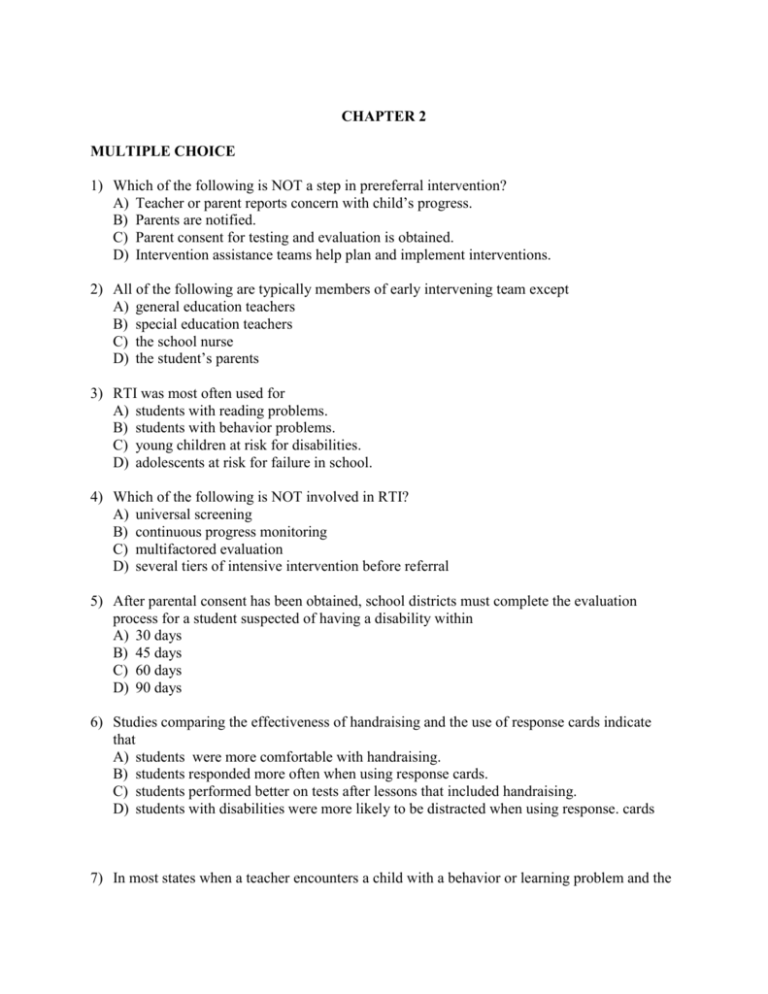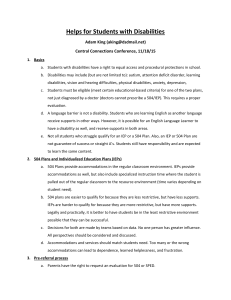Special Education Test: Interventions, IEPs, Co-teaching
advertisement

CHAPTER 2 MULTIPLE CHOICE 1) Which of the following is NOT a step in prereferral intervention? A) Teacher or parent reports concern with child’s progress. B) Parents are notified. C) Parent consent for testing and evaluation is obtained. D) Intervention assistance teams help plan and implement interventions. 2) All of the following are typically members of early intervening team except A) general education teachers B) special education teachers C) the school nurse D) the student’s parents 3) RTI was most often used for A) students with reading problems. B) students with behavior problems. C) young children at risk for disabilities. D) adolescents at risk for failure in school. 4) Which of the following is NOT involved in RTI? A) universal screening B) continuous progress monitoring C) multifactored evaluation D) several tiers of intensive intervention before referral 5) After parental consent has been obtained, school districts must complete the evaluation process for a student suspected of having a disability within A) 30 days B) 45 days C) 60 days D) 90 days 6) Studies comparing the effectiveness of handraising and the use of response cards indicate that A) students were more comfortable with handraising. B) students responded more often when using response cards. C) students performed better on tests after lessons that included handraising. D) students with disabilities were more likely to be distracted when using response. cards 7) In most states when a teacher encounters a child with a behavior or learning problem and the child is not currently receiving special education services, the first step is to A) devise and implement an intervention B) design an individualized education program C) contact the state board of education to request funding D) evaluate the child for eligibility to receive special education services 8) Compared to students of other racial and ethnic groups, African American students are most likely to be identified as having A) autism B) intellectual disabilities C) specific learning disabilities D) speech or language impairments 9) Which of the following groups are generally underrepresented in special education? A) Asian Americans B) European Americans C) Hispanic Americans D) Native Americans 10) All of the following contribute to disproportionate representation of diverse students in special education except A) biased referrals B) inaccurate assessment C) ineffective instructional practices D) inconsistent parental involvement 11) Which of the following statements about an IEP is true? A) An IEP is a permanent document. B) An IEP must be reviewed every three years. C) An IEP must be revised when student needs change. D) Only academic goals need to be revised on an annual basis. 12) In program planning, the evaluation team determines all of the following except A) learning goals and objectives B) causation of the disability C) providers of special education and related services D) frequency of specialized instruction and related services 13) Which of the following best represents the concept of teaming? A) A group of teachers share bus duty. B) A paraeducator designs a bulletin board for a special educator. C) A special educator provides a list of possible accommodations for a student to a general educator. D) A special educator and a general educator design assignments and assessments for a student and meet to share results. 14) Mrs. Jonas, a speech therapist, Mr. Dodds, a physical therapist, and Mrs. Anthony, a special education teacher, work independently to provide services to Jasmine, a student with cerebral palsy. Mrs. Jonas addresses Jasmine’s articulation problems. Mr. Dodds focuses on helping Jasmine walk with braces, and Mrs. Anthony works on Jasmine’s reading and math goals. Which type of team is described in this scenario? A) interdisciplinary B) intradisciplinary C) multidisciplinary D) transdisciplinary 15) Brianna’s general education teacher and the speech therapist at her school communicate to make sure that her therapy sessions end before it is time for related arts classes. This is an example of A) consultation B) teaming C) reciprocity D) coordination 16) Mrs. Watkins, a fifth grade teacher, and Mrs. Dubois, a special educator, want to begin teaching a unit on fractions. They want to keep group size small so they each teach the same lesson to an equal number of students. Which model of co-teaching is described in this scenario? A) alternative teaching B) parallel teaching C) station teaching D) team teaching 17) Mr. Nelson helps a group of third graders who are gifted to make crystals while Mr. Waun engages the remaining students in a more traditional science lesson. Which model of coteaching is described in this scenario? A) alternative teaching B) one teaching-one helping C) parallel teaching D) team teaching 18) Successful co-teaching requires all of the following except A) flexibility B) a sense of humor C) meticulous planning D) open communication 19) A representative of the local education agency must be included on an IEP team A) B) C) D) to ensure that the meetings are orderly to explain the results of assessments administered to ensure inclusion in general education classes to explain the availability of resources through the local education agency 20) Benchmarks or short-term objectives are required A) for all students with disabilities B) for infants and toddlers with disabilities C) for students with disabilities in segregated settings D) for students with disabilities who take alternate assessments 21) All of the following are general factors that must be considered by team members developing an IEP except A) the communication needs of the child B) the results of the most recent evaluations C) the academic, developmental, and functional needs of the child D) the concerns of parents for enhancing the education of their child 22) Which of the following statements about an IEP is inaccurate? A) An IEP is a measure of accountability. B) A school district is legally obligated to provide the services described in the IEP. C) Teachers and school districts can be sued if a student does not meet the goals in the IEP. D) Schools must be able to show that they made a conscientious effort to achieve the goals in the IEP. 23) Which of the following is an example of a measurable annual goal? A) By the end of the school year, Jason will learn to read. B) By May of 2012, Elizabeth will control her anger when teased. C) By the end of the school year, Mary Ellen will improve her study skills. D) By the end of the school year, Erin will read a third grade level reading selection with 95% accuracy. 24) Recent studies of actual IEPs indicate that A) they are data based and creative. B) they are often useless to parents and students. C) they have improved greatly over the past 20 years. D) they represent the best of educational interventions. 25) To be sure that students with disabilities receive the highest quality of instruction, teachers are required to use A) curriculum-based assessment B) evidence-based practices C) peer-initiated strategies D) small-group instruction 26) Mrs. O’Shea believes that a combination of practices is better than a single practice. One disadvantage of her eclectic approach is A) B) C) D) only the most important parts of a practice may be used some parts of a practice may be implemented for too long elements of different practices may be incompatible with one another teachers may adopt a perfectionist attitude when implementing multiple practices 27) Which of the following statements about least restrictive environment is true? A) The LRE may change over time. B) The LRE is the setting that is the most diverse. C) The LRE is the resource room for most students. D) The LRE is determined by the disability category. 28) How often does IDEA require teams to review IEP goals and objectives for each child? A) every six months. B) quarterly C) every other month D) annually 29) IDEA requires that an individualized education plan be developed for all students with disabilities between the ages of A) birth to 21 B) 3 to 18 C) 3 to 21 D) 6 to 21 30) Which school policy best illustrates the concept of least restrictive environment? A) All students with disabilities are included in general education classrooms. B) Students with severe disabilities spend part of the day in segregated settings. C) Students with disabilities are educated with peers without disabilities to the maximum extent appropriate. D) Students with disabilities cannot be removed from general education classes for more than 45 minutes each day. 31) Which of the following statements about inclusion is true? A) Most parents of students with disabilities support inclusion. B) Most parents of children with severe disabilities oppose inclusion. C) Many parents of children with disabilities support inclusion and others oppose it D) Many parents of children with disabilities support inclusion in theory but most oppose it in practice. 32) Which of the following is an overlooked requirement of IDEA? A) the provision of in-service training for general educators B) the provision of teaching assistants for general educators C) the provision of common planning time for general educators and resource teachers D) the provision of increased planning time to design lEPs for general and special educators 33) Which factor has the greatest impact on student achievement in inclusive classrooms? A) the quality of instruction B) the number of students with disabilities included C) the severity of the disabilities displayed by the students D) teacher and student attitudes toward students with disabilities 34) All of the following are characteristics of cooperative learning except A) shared goals B) individual accountability C) small homogeneous groups D) group recognition for success 35) Which classwide peer tutoring model involves reading and responding to items on teachermade study guides or concept cards? A) the Ohio State model B) Peer Assisted Learning Strategies C) Juniper Gardens Children’s Project D) SUNY Fredonia Classwide Student Tutoring Teams 36) All of the following are required components of an IEP except A) annual goals B) measures of progress C) statement of parental supports D) description of frequency and duration of services 37) One strategy for integrating students with disabilities in both academic and social environments is A) cooperative learning B) games based learning C) field based experiences D) using aides and shadows 38) Which of the following is an ineffective inclusion strategy? A) classwide peer tutoring B) co-teaching with a special educator C) implementing accommodations and modifications D) placing a student with a disability in general education to see if he/she can succeed 39) Studies of parents who contest school placement decisions for their children with disabilities indicate that A) many parents wanted full inclusion B) many parents wanted a more restrictive setting C) many parents wanted a less restrictive setting D) many parents wanted smaller classes and instructional support 40) Which of the following research methodologies is considered the gold standard for identifying an effective instructional practice? A) Action Research B) Correlation Coefficients C) Qualitative Research Designs D) Randomized Controlled Trials SHORT ANSWER 1) Describe the prereferral process including its purpose. 2) IDEA presupposes what placement alternative as the starting point for the least restrictive environment? Why? 3) Identify the type of team composed of professionals who work independently of each other. Explain how this team functions. 4) List the seven members of the IEP team. 5) The transition statement and plan includes information about how the student will transition from school to _____________. Describe what the transition statement should include. 6) What is “the single most unpopular aspect of” IDEA and why is it unpopular? 7) What 2 members of the IEP team rate themselves the lowest on ability in and understanding of the IEP meeting process? 8) What does PLOP stand for and include? 9) Which placement option is characterized by attendance for only part of the day with specialized instruction and who provides this service? 10) Who determines what the LRE and special education services will be for a student with disabilities and what legally mandated sequence is followed? TRUE/FALSE 1) 2) 3) 4) Prereferral intervention is required by IDEA. RTI can prevent placement in special education. School districts must use RTI to identify students with learning disabilities. Culturally and linguistically diverse students are both over- and underrepresented in special education. 5) Co-teaching is commonly used in self-contained classes. 6) Having two teachers in a classroom ultimately improves instructional effectiveness. 7) School districts may exceed the requirements of the law when creating an IEP. 8) Studies of actual IEPs support the consistency between what is written and what is implemented. 9) An IEP is a curriculum for a student with a disability. 10) Most general education teachers feel comfortable participating in IEP meetings. 11) In a resource room placement, a child is with other children with disabilities for most of the day. 12) Least restrictive environment and inclusion are not synonymous. ESSAY 1) Explain the continuum of service and placement options in order from least to most restrictive. 2) What components must be included in a student’s individualized education program? 3) Explain the steps in the special education process. 4) Explain the controversy regarding full inclusion. 5) Discuss the disproportionate representation of culturally diverse groups in special education. Include the suspected contributing factors. ANSWER KEY: CHAPTER 2 MULTIPLE CHOICE 1) 2) 3) 4) 5) 6) 7) 8) C D A C C B A B 9) 10) 11) 12) 13) 14) 15) 16) A D C B D C D B 17) 18) 19) 20) 21) 22) 23) 24) A B D D A C D B 25) 26) 27) 28) 29) 30) 31) 32) B C A D C C C A 33) 34) 35) 36) 37) 38) 39) 40) A C D C A D B D SHORT ANSWER 1) Answers may vary but should indicate that Prereferral intervention occurs before referral to special education and is intended to help teachers devise interventions for students experience learning or behavior problems. 2) general education classroom; the answer to why should indicate that IDEA that children with disabilities should be educated with their peers without disabilities unless the severity of the disability prevents this 3) Multidisciplinary; answers to how it function should indicate that each team member conducts assessments and delivers services 4) Parents, regular education teacher, special education teacher, LEA representative, someone to interpret evaluations, student (if appropriate), other invited by district or parents 5) adult life; answers to what the transition statement should include should indicate appropriate postsecondary goals based upon age appropriate transition assessments related to training, education, employment, and where appropriate independent living skills; and the transition services needed to assist the child in reaching those goals; and , one year before the child reaches the age of majority, a statement that the child has been informed of his/her rights under this title. 6) the IEP; essence of plan lost in mountain of paperwork 7) general education teachers and students 8) present levels of performance and includes how the disability achievement and functional performance 9) resource room; services, in the resource room, is provided by the special educator 10) the IEP team; answers to the legally mandated sequence should include determining whether the child has a disability and is eligible for special education, determining the child’s needs and developing an IEP that specifies special education and related services, and placing the child in a LRE where an appropriate program can be provided so the child can make progress TRUE/FALSE 1) 2) 3) 4) 5) 6) False True False True False False 7) 8) 9) 10) 11) 12) True False False False False True ESSAY 1) general education classroom general education classroom with consultation general educations classroom with supplementary instruction and services resource room separate classroom separate school residential school homebound or hospital 2) Answers must contain the following seven components: present levels of performance annual goals and short-term objectives statement of the special education and related services the extent, if any, to which the child will not participate with nondisabled peers in regular classroom testing modifications projected date for beginning of services and anticipated frequency, location, duration of services how progress will be measured 3) Answers will vary but should include these steps: • prereferral intervention—if not successful, then MFE • identification of a disability • plan IEP • place in LRE • implement • review and evaluate 4) Answers will vary but may include the ideas that a) full inclusion advocates believe that education outside the general education classroom constitutes segregation and all negative connotations associated with it; b) full inclusion advocates believe the benefits extend to students without disabilities; c) full inclusion opponents insist that placing a child in a general education classroom without the appropriate supports and services provides no benefits and in fact may be harmful in as much as opportunity for education is lost; and/or d) some services are more appropriately provided in other settings. 5) Answers will vary but should include information about the inaccurate and biased identification process, cultural incongruity between the majority of teachers and diverse student populations, and a curriculum not effective for some culturally diverse populations.





